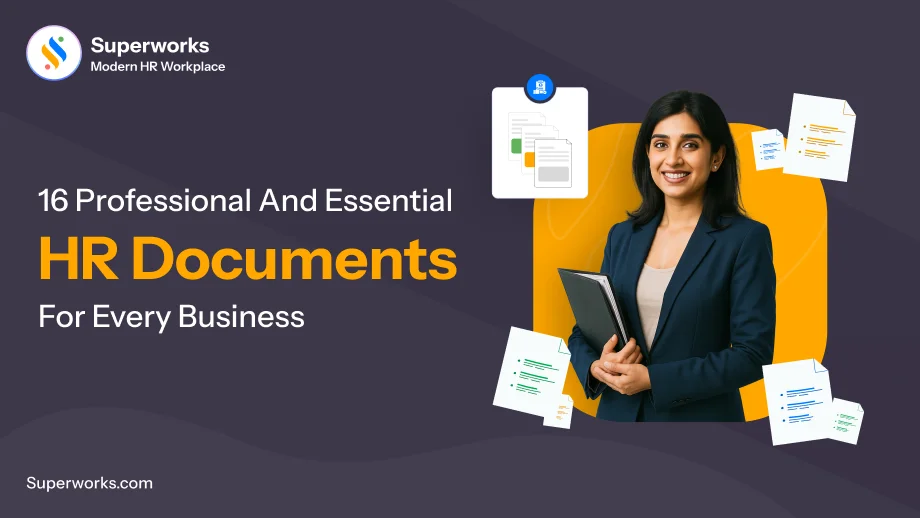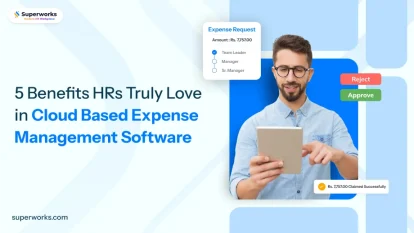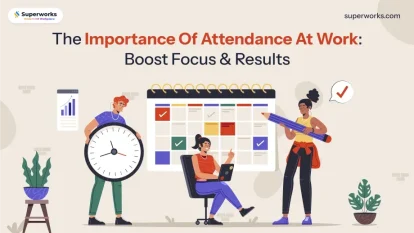Grab a chance to avail 6 Months of Performance Module for FREE
Book a free demo session & learn more about it!
-
Will customized solution for your needs
-
Empowering users with user-friendly features
-
Driving success across diverse industries, everywhere.
Grab a chance to avail 6 Months of Performance Module for FREE
Book a free demo session & learn more about it!
Superworks
Modern HR Workplace
Your Partner in the entire Employee Life Cycle
From recruitment to retirement manage every stage of employee lifecycle with ease.



Seamless onboarding & offboarding
Automated compliance & payroll
Track performance & engagement
16 Professional And Essential HR Documents For Every Business
- HR documents for small business
- 9 min read
- December 13, 2023
What are the most important HR documents for your company? Whenever this question comes into the scene, people tend to get confused while choosing one of them.
Because no one can deny the fact that numerous businesses must depend on various departments for their success. And without any doubt, the human resources department is one of the most vital divisions in an organization that employs people and handles all the crucial documents.
And while choosing one important HR document, one has to keep this one thing in mind, that it completely depends on how well you want to avoid legal trouble, stay organized, and keep your employees informed.
Some companies skip proper documentation and end up scrambling during audits, lawsuits, or even onboarding. The truth is, HR documents are not optional—they are the backbone of smooth human resource management. From job descriptions to contracts and exit forms, this blog will walk you through:
Why do these documents matter?
- The types you should always keep ready
- A complete checklist of 16 professional HR documents
- How HRMS software like Superworks can simplify it all
You’ll also get practical tips to keep your files accurate, updated, and easy to find.
- Why are HR Documents Important?
- Types of HR Documents
- 16 HR documents Every Small Business Should Have
- 1. Job description
- 2. Organization chart
- 3. Staffing plan
- 4. Employee handbook
- 5. Compliance documents
- 6. Performance metrics and documents
- 7. Time and attendance policy
- 8. Exit documents
- 9. Compensation and benefits overview
- 10. Recruiting documents
- 11. Company values
- 12. Expense tracking
- 13. Dress code policy
- 14. Onboarding documents
- 15. Training and development
- 16. Contracts
- How Super HRMS Can Help Get All HR Documents?
- conclusion
Why are HR Documents Important?
HR documents for small business and large exist to protect the company, guide employees, and support compliance.
Every business—no matter the size—needs proper HR documentation to stay on track. These documents prove what was agreed upon, what policies are in place, and how employees are treated. They’re key during audits, legal issues, and internal reviews.
Here are the HR documents that we are talking about:
- Legal proof: Written records prevent misunderstandings and protect against lawsuits.
- Employee clarity: Documents like job descriptions and handbooks make sure employees know what’s expected.
- Standard processes: HR forms keep hiring, onboarding, training, and exits consistent.
- Data tracking: Performance reviews, attendance records, and compensation details help make better decisions.
- Audit-ready: Proper HR documentation helps during labor inspections or tax reviews.
HR documents for employees also create transparency. Workers know where they stand, what benefits they receive, and how performance is judged. That improves trust.
Without the right paperwork, even a simple leave request can turn into confusion.
Want to streamline your HR document management?
Then choose Super HRMS to store, organize & access your documents securely & efficiently.
Types of HR Documents
HR documents fall into a few key categories: administrative, legal, and employee-focused. Each type plays a different role, but all are essential for smooth HR operations.
1. Administrative HR Documents
These help run day-to-day HR tasks:
- Job descriptions
- Organizational charts
- Staffing plans
- Time and attendance records
2. Legal and Compliance HR Documents
These are required to follow laws and protect your business:
- Contracts
- Compliance forms
- Employee tax documents
- Exit paperwork
3. HR Documents for Employees
These are created for employee understanding and support:
- Employee handbook
- Benefits overview
- Company policies (dress code, conduct)
- Training and development materials
Each category supports different parts of the employee lifecycle—from hiring to retiring. Having a proper HR document for each step prevents delays and confusion.
16 HR documents Every Small Business Should Have
1. Job description
Job description is important to clarify the responsibilities of a vacancy. It provides initial responses to the candidates’ questions to start with. Such an HR document could include details of the major responsibilities of the position and pay, basic requirements, and so on. It assists in finding a new employee for an available position at your company. In conclusion, a good job description is an important element of recruitment.
2. Organization chart
As for the new employees, this HR document is most relevant. An organizational chart explains the company’s employee structure. It demonstrates how each job links to the other, and the person who is in charge of overseeing the management of different people in a company.
They can be useful for old or new employees within the company. It serves as a reference material for individuals who might be interested in learning more about the structure of the organization.
3. Staffing plan
In other words, every HR department must develop its staffing plan. The process involves evaluating the existing competencies in an organization, identifying skill gaps, and then comparing them with the company’s goals.
It is instrumental in that it assists HR professionals in knowing the type of employees they might require and prioritizing recruitment efforts on such needs. Moreover, it may help you understand if it is good to bring in a new employee during the growth of any stage of your business.
4. Employee handbook
The organization usually issues an employee handbook to all employees. A new employee will always refer to the company’s employee handbook as a point of reference regarding policies, expectations, and benefits. A typical employee handbook may also include attendance policies and a description of the company culture.
5. Compliance documents
The compliance HR documentation is the set of records and employee data on the laws and legal regulations. Such information would include payroll, employee benefits or compensation, taxes, insurance, and many other items. This information can also be confidential in many instances. With HR document management software, you can control who has access to it.
6. Performance metrics and documents
Performance measures lay the foundation for setting expectations for employees. These documents provide the basis for conducting performance appraisals. These documents can be used to supplement job descriptions and include an explanation of the evaluation process, discipline processes, and copies of managerial letters.
Similarly, an HR department could provide a template of a warning letter to be sent to an employee who had violated a policy. If you’re using HR document management software, you might also find ready-to-use templates for these HR documents.
7. Time and attendance policy
This document is critical in creating the policy for the organization on time and attendance. It describes the working time and overtime for employees and the associated penalties for non-compliance. In addition, it might be why employees can record their presence in the organization and hours.
8. Exit documents
Likewise, the HR department will have to process the workers who are exiting the organization. Such HR documents may include information on notice expectation, letter of recommendation, or exit interview.
9. Compensation and benefits overview
Data about the compensation and benefits provided by the firm is maintained by the HR department. Pay cycles, salary structures for different employees, official processes, and explanations of how pay cycles work. For instance, benefits may include what the company does for employees and when they are entitled.
10. Recruiting documents
Recruiting documents are used in planning and implementing the recruiting processes in the HR department. These would include offer letter templates, interviewing materials, reference-checking guides, and employee hiring policies.
This way, it will also help in developing an organizational system that will display the candidate’s progress through the process in a way that would be clear way. With this software, you can easily record and update these documents.
11. Company values
HR documentation for company values may include the company’s history, mission, values, and vision. The above information helps employees familiarize themselves with the company and understand the kind of behavior that is expected from them to ensure that their actions align with the company’s general spirit and mission.
12. Expense tracking
Some firms allow employees to submit their expenses to the company so that the company can reimburse them. The HR department should also tell what expenses are covered and who is eligible for reimbursement. The document can also specify the mode of sending the expenses and the refund mode.
13. Dress code policy
Many organizations will set down a dress code. This HR document allows the company to project a certain image to the public. Therefore, it’s good to specify the appropriate and inappropriate work attire. Mention the consequences of disobeying the policy and the possible adjustments that may be provided to the employees.
14. Onboarding documents
Onboarding documents comprise all the paperwork and information that the HR department needs new employees to provide. This could be an onboarding checklist, a new hire checklist, an outline of a process to be taken, and copies of company policies for an employee to read.
15. Training and development
The HR department should keep its training and development documents ready. Such documents outline employees’ expectations to complete relevant training.
It’s good to have HR documents that explain if the organization reimburses the employees for additional training they take, such as through a tuition reimbursement program, etc.
16. Contracts
The HR Department may be involved in drafting as well as updating several different contracts. Furthermore, these agreements may cooperate with lawyers to guarantee that they are legal. The common contracts or templates they keep include new hire contracts, contracts for freelance workers, etc.
How Super HRMS Can Help Get All HR Documents?
Technology can help in this way, because most HR departments can’t collect all the HR documents easily. In this case, most of the HRMS software can help to collect important HR documents. So, if you are looking for reliable, best-in-industry HRMS Software? Look no further than Superworks!
Our Super HRMS is equipped with everything you need. From managing employees to documents, we’ve got you covered! Why don’t you check out our advanced Super HRMS today?
conclusion
When a company starts to use an elite HR document management system like Super HRMS, it not only saves time but also streamlines HR management. Because you know, nowadays it’s quite impossible to have smooth human resource management without job descriptions, contracts, and other must-have HR documents.
So, it’s quite simple in these modern times, if you want your HR team to focus on the company’s growth, you’ve got to provide a highly efficient document management system. Because without it, they just can’t grow. Moreover, investing in reliable HRMS software like Super HRMS can improve HR document management and overall HR efficiency.




